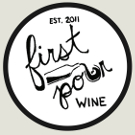Welcome to First Pour Wine Episode 5. On this episode we’re going to be taking a look at some whites that might also be good wines for drinking this summer. In the written content, we’ll be talking about:
- Dry vs. Sweet
- Reviewing: 2008 Covey Run Gewürztraminer & 2009 Sauvion Vouvray
Dry vs. Sweet
In general, wine is classified as dry or sweet. The vast majority of wine is considered dry, meaning that it has little to no sugar content. There are technical specifications that attempt to define this, such as less than .2% residual sugar remaining, but these are by and large unnecessary, since most wine is considered dry. Be aware, this means natural sugar, not sugar that can be added during other steps of wine making.
Dry wines do not necessarily lose their ability to be fruity or taste of honey. These tastes exist outside the spectrum of sugar. Much like vanilla extract can smell sweet, but taste incredibly bitter.
On the far other end of the spectrum, there are sweet wines. Sweet wines can be produced in a variety of ways.
- Grapes can contract a fungus, Botrytis Cinerea, known occasionally as noble rot (this is a very specific type of mold, not just rotten grapes, do NOT try this at home). This is a rare occasion of fungus being good, where instead of destroying the grape, it removes water, concentrating the flavor.
- The grapes can be left to raisin before being pressed, producing sweet dessert wines.
- Grapes can also be left to ripen on the vine in northern climates, and then pressed once naturally frozen. Known as ‘ice wine‘, this eliminates water and concentrates the wine’s sweetness.
- The grapes can also be allowed to stay on the vine past harvest before being picked. This is known as late harvest, and causes the grapes to contain more sugar.
- Finally, as fermentation is the act of sugar being converted into alcohol by yeast, fermentation can be stopped through fortification (the act of adding neutral spirits to raise the alcohol, killing the yeast while sugar is still present).
So what is between sweet and dry? Off-dry.
Off -dry wines are slightly different than either. Off-dry wines are when fermentation is stopped before the yeast can finish the alcohol. This is done by adding a small amount of sulfur dioxide to kill the yeast or chilling the wine, and filtering the yeast. In this small way, off-dry wines and fortified wines are sort of similar.
There is a whole spectrum of sweetness terms, which are useful when dealing with sparkling wines, but for now, just remember:
- Dry : Little to no sugar
- Off Dry / Semi-dry / Semi – sweet: Some sugar, but not overly sweet.
- Sweet: Plenty of sugar, possible dessert wine.
Without further delay, the wines:
2008 Covey Run Gewürztraminer
This wine is potentially a very good choice for dry white drinkers in the summer. Gewürztraminer is wonderful for pairing with spicy summer fishes and chicken dishes, while simultaneously having enough fruit to make for a fine wine to drink on it’s own. This particularly Gewürztraminer hails from Washington’s Columbia Valley, how does it do?
Sight: Moderate amount of light yellow gold developing, starting to age barely.
Smell: Melon, starfruit, and a touch of apple are surrounded by a menagerie of floral smells including roses, violets, jasmine, lavender, and lilies.
Sip: A wink of powder sugar appears in the start before being replaced by lilies and melon. There is a touch of start fruit, and a moderate body to this wine. (ABV 13%)
Savor: Not much spice, but plenty of rose and lilies. Slightly bitter, with a moderate length.
At the price, $6.45, this wine is pretty darn good. While it isn’t particularly complex, it’s well made, with no real flaws. It lacks some of the spicy notes that Gewürztraminer can have, but for a change of pace from fruity whites, this is a great side trip into the florist.
Price: $6.45
Columbia Valley, Washington
http://www.coveyrun.com/
Vouvray, made by law, from 100% Chenin Blanc, is exclusively from the Liore Valley in France. While this sounds like nothing particularly special, some of the very best examples of Chenin Blanc in the world come from Vouvray, Unlike it’s cousin, Savennières, Vouvray is not a rare and expensive wine, and makes many decent examples under $10. Vouvray is a sugar-shifter, and can be anywhere from bone dry to cloyingly sweet, but is always known for it’s sparking acidity. While there could be a long discussion on classification of Vouvray, this would be an easier time to put a cork in it, and drink this semi-dry example.
Sight: Straw, on a bright, sunny day.
Smell: Nectarines and lemon pith are placed on a limestone tray by the sea. Salty spray and minerality are prevalent in the wine behind the fruit.
Sip: Fruity citrus bursts forth with sweetness, before tempering to acidic minerality including wet limestone and slight saltiness. The body is light to moderate, and the acid keeps things vibrant (ABV 12%)
Savor: Lemon and wet stones linger calmly, pleasantly begging for fresh seafood.
This wine is a great pairing for summer time shellfish, be they oysters or shrimp. The wine is crisp, refreshing, and not so sweet as to be distracting. Rather, it keeps surprising by alternating it’s character between sweet and acidic, but never imposing either strongly. Quite enjoyable, if not very fruit forward.
Price: $9.45
Liore, France
